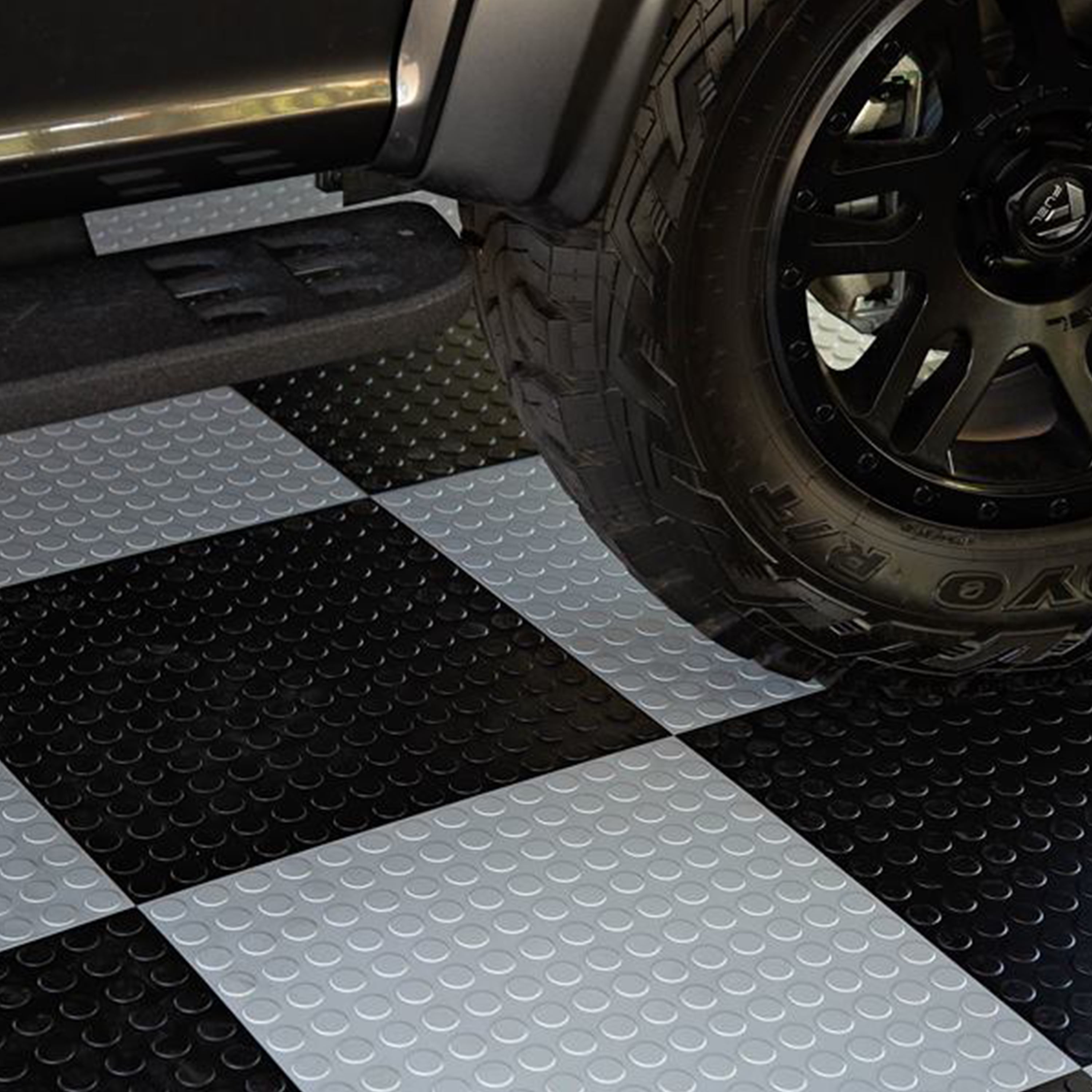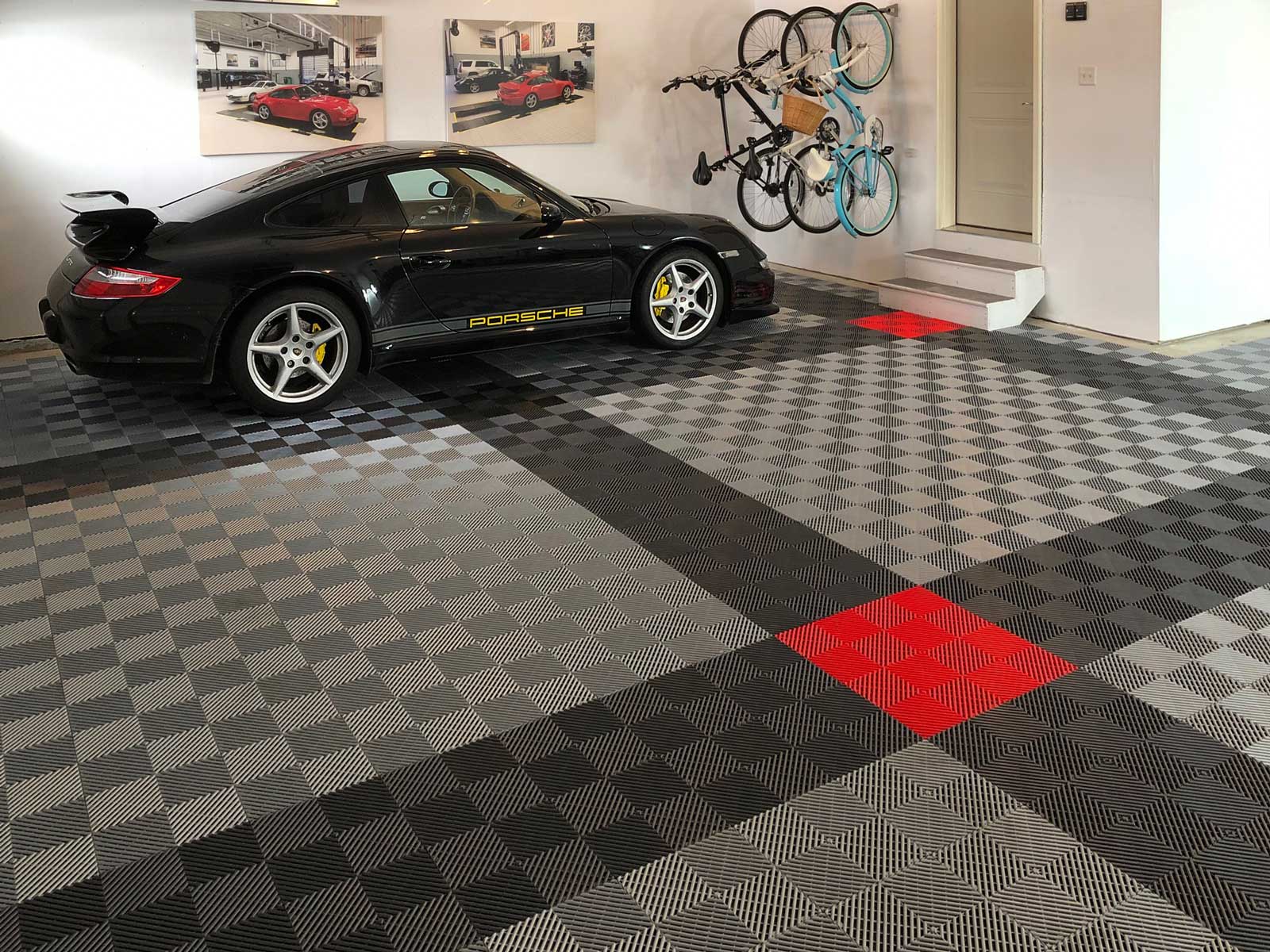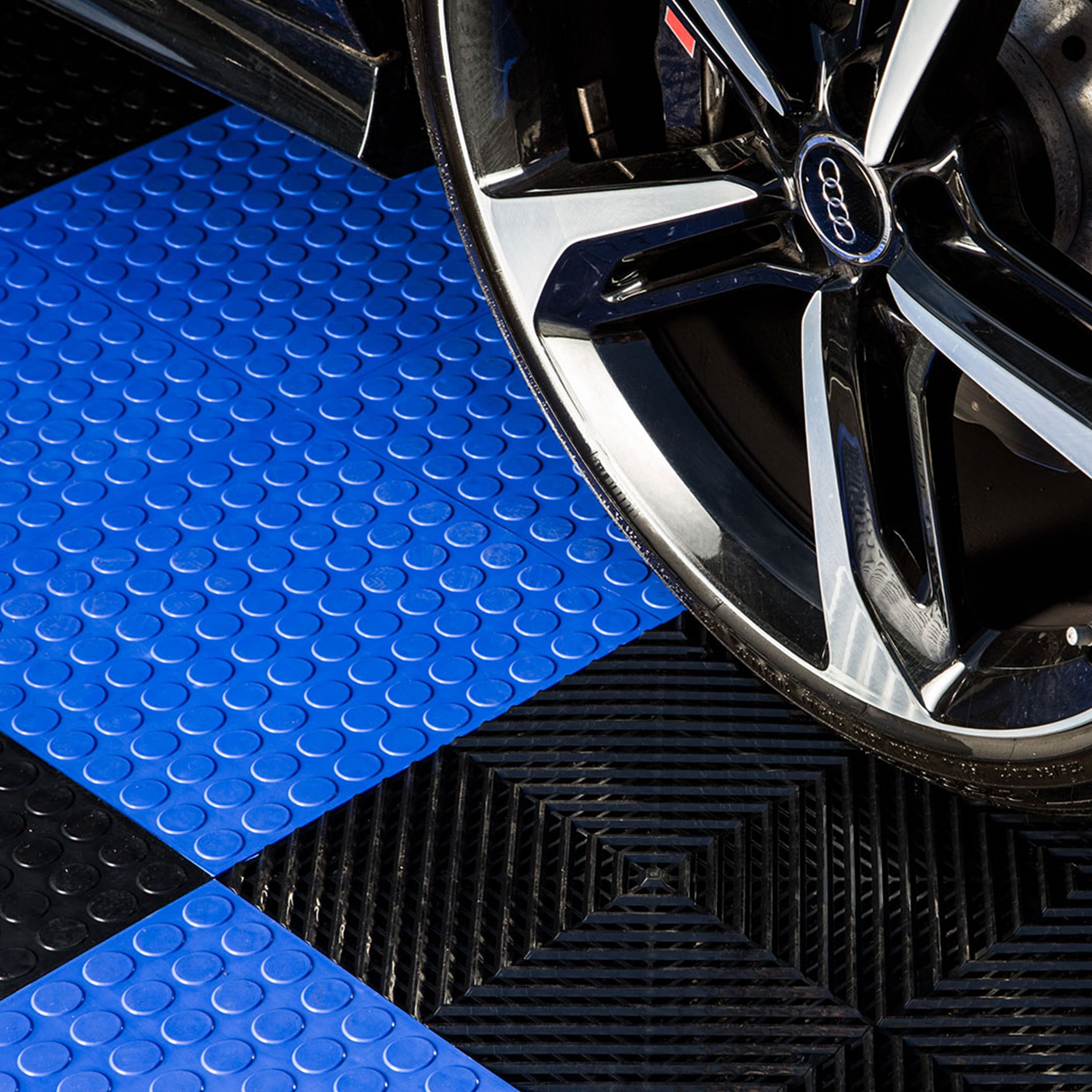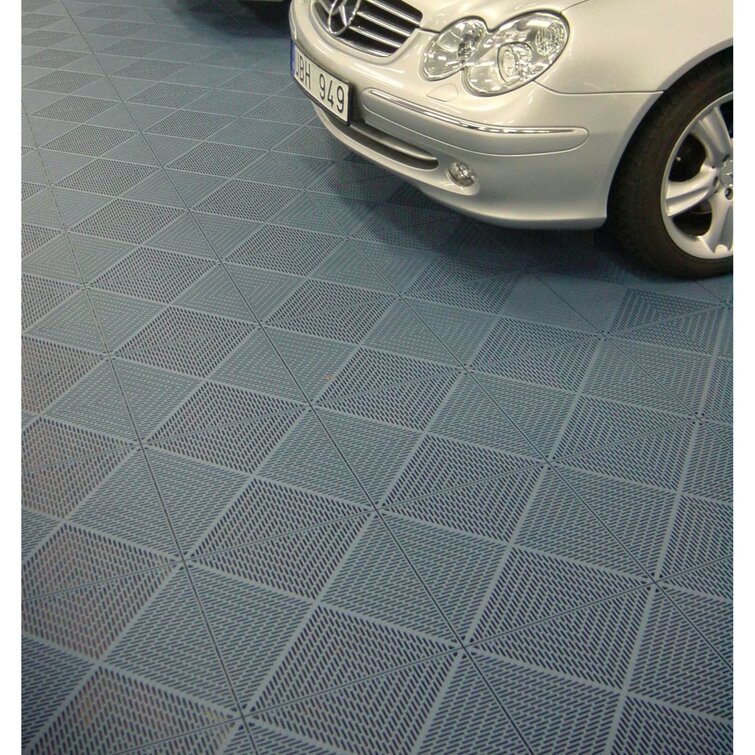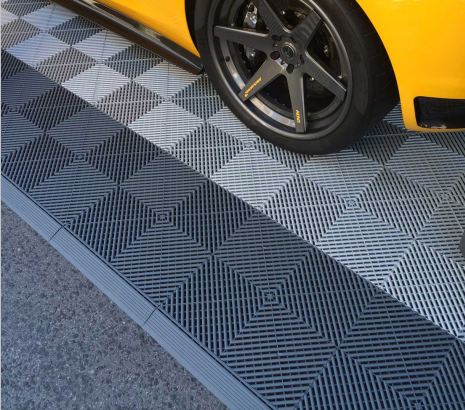Types of Garage Floor Tiles: Which is Right for Your Space?
When I first looked into upgrading my garage floor, I was amazed at the range of tile options available. Choosing the right type can feel overwhelming, but understanding the various options helps make the decision easier. Whether you need something heavy-duty for car maintenance or a stylish finish to turn your garage into a multi-purpose space, there’s a tile that suits your needs. Here’s a breakdown of the most popular types of garage floor tiles and how to decide which is best for your space.
- Rigid Plastic (PVC) Tiles
Rigid plastic tiles are one of the most durable options out there. Made from polypropylene or PVC, these tiles can handle heavy loads and are resistant to chemicals and moisture. If you’re looking for a long-lasting solution that can withstand oil spills, car traffic, and general wear and tear, rigid plastic tiles are a great choice. They also come in a variety of colors and designs, allowing you to customize your garage’s look. - Flexible Rubber Tiles
Flexible rubber tiles are ideal for those who spend a lot of time standing or working in the garage. These tiles provide a cushioned, anti-fatigue surface that’s comfortable underfoot. They’re also non-slip, making them perfect for areas that might get wet. While they aren’t as tough as rigid tiles for heavy-duty use, rubber tiles are easy to install and offer excellent shock absorption. - Peel-and-Stick Vinyl Tiles
If you’re on a budget and want a simple solution, peel-and-stick vinyl tiles are a convenient option. These tiles are easy to install and come in various designs, including those that mimic the look of stone or wood. They may not be as durable as rigid plastic tiles, but for light-use garages or spaces where aesthetics are a priority, they can work well. Keep in mind that these tiles can lift over time, especially in high-moisture areas. - Interlocking Foam Tiles
Interlocking foam tiles are lightweight, easy to install, and provide excellent cushioning. While they’re not ideal for heavy-duty vehicle use, they work well in sections of your garage where comfort is important, like a workout area or workspace. Foam tiles are also affordable, and because they interlock like puzzle pieces, they can be quickly rearranged or replaced if damaged. - Porcelain or Ceramic Tiles
For those seeking a premium finish, porcelain or ceramic tiles offer a sleek, high-end look. These tiles are incredibly durable and resistant to water, chemicals, and stains. However, they can be slippery when wet and may crack under heavy loads like car tires, so they’re better suited for garages used for storage or as living space extensions rather than full-time car parking. - Coin or Diamond Patterned Tiles
Some rigid plastic or rubber tiles come in special surface textures, like coin or diamond patterns. These tiles add traction and a more industrial look to your garage. I like these options because they help prevent slips and give the garage a professional, finished appearance. The raised patterns also help hide scuffs and dirt, keeping the garage looking clean and polished.

Benefits of Installing Garage Floor Tiles
I used to think of my garage as purely functional, but after installing floor tiles, it became a space that was both practical and visually appealing. Garage floor tiles offer more than just aesthetics—they can improve the durability, safety, and overall experience of using your garage. Whether you’re looking to turn your garage into a home gym or a workshop, these tiles offer plenty of advantages. Here are some of the top benefits of installing garage floor tiles.
Improved Durability
One of the first things I noticed after installing garage floor tiles was how much more durable the floor became. Garage tiles, especially those made from rigid plastic or rubber, can handle the weight of cars, tools, and equipment without showing wear and tear. Unlike bare concrete, which can crack and stain over time, tiles protect the floor from damage and extend its lifespan.
Enhanced Aesthetic Appeal
If you’re tired of the dull, unfinished look of a concrete garage floor, tiles can transform the space. With a wide variety of colors, patterns, and materials, you can customize your garage floor to match your style. Whether you want a sleek, modern look or a more industrial vibe, tiles give you the flexibility to create a space that reflects your taste.
Ease of Installation
Garage floor tiles are generally easy to install, making them an appealing option for DIY enthusiasts. Many types of tiles, like interlocking plastic or foam tiles, snap together without the need for adhesives or special tools. This means you can install them yourself in just a few hours. Plus, if one tile gets damaged, it’s easy to replace it without redoing the entire floor.
Resistance to Stains and Spills
Another huge benefit of garage floor tiles is their resistance to chemicals, oil, and other spills. If you use your garage for car maintenance or woodworking, this is especially important. Spills that would otherwise stain or damage a bare concrete floor are easy to clean up on a tiled surface, as many tiles are stain-resistant and wipe clean with minimal effort.
Enhanced Safety
I was always concerned about the slippery nature of my garage’s concrete floor, especially when it got wet. With textured or rubber tiles, you can reduce the risk of slips and falls. Some tiles even have anti-slip features built in, making them perfect for high-traffic areas or garages that see a lot of water, like in rainy climates.
Increased Comfort
If you use your garage as a workspace or home gym, comfort becomes a big factor. Standing on hard concrete for long periods can cause discomfort and fatigue. Rubber or foam tiles, in particular, offer a cushioned surface that’s easier on your feet and joints, making the space more comfortable to use for extended periods.
Choosing the Best Material for Garage Floor Tiles
When I first considered upgrading my garage floor, I was overwhelmed by the sheer number of material options for tiles. Each type of material has its strengths and weaknesses, depending on how you plan to use your garage. From heavy-duty workspaces to light recreational areas, choosing the right material ensures your floor can handle the tasks ahead. Here’s how to determine which garage floor tile material is best for your needs.
Plastic (Polypropylene or PVC) Tiles
Plastic garage tiles are incredibly durable, and able to withstand the weight of vehicles, tools, and heavy equipment. They are resistant to oil, grease, and chemicals, making them ideal for mechanics or those who perform regular vehicle maintenance. If you need something easy to clean, these rigid plastic tiles are perfect, and they come in a variety of patterns and colors to suit your aesthetic preferences.
Rubber Tiles
Rubber tiles are softer than plastic tiles and provide a comfortable surface for standing or working. These tiles are also non-slip and shock absorbent, which makes them ideal for areas where you might be doing a lot of physical labor or using gym equipment. They can also dampen sound, which is helpful if you’re working with loud machinery or tools.
Vinyl Tiles
If aesthetics are your top priority, vinyl tiles are an excellent option. These tiles can be designed to mimic other flooring materials like wood or stone and come in peel-and-stick versions for easy installation. While they may not be as durable as plastic or rubber, they’re great for garages that are used more for recreational purposes or as an extension of your living space.
Foam Tiles
Foam tiles are lightweight, easy to install, and provide the best cushioning. They’re an excellent option for creating a gym space or a comfortable work area in your garage. However, foam isn’t as durable as other materials, so if you plan on driving or storing heavy equipment in the garage, foam tiles may not hold up as well over time.
Ceramic or Porcelain Tiles
For those seeking a sleek, upscale finish, ceramic or porcelain tiles are an option. These tiles are waterproof, easy to clean, and resistant to chemicals. However, they’re more brittle than plastic or rubber tiles and can crack under the weight of vehicles, so they’re better suited for garages used for storage or non-heavy-duty purposes.
Composite Tiles
Some garage floor tiles combine multiple materials, such as a plastic core with a rubber top layer. These composite tiles offer the best of both worlds: the durability of plastic with the comfort and slip resistance of rubber. If you’re looking for a versatile solution that can handle both cars and physical activity, composite tiles might be the right choice for you.
Step-by-Step Guide to Installing Garage Floor Tiles
Installing garage floor tiles was one of the most satisfying DIY projects I’ve ever tackled. It’s relatively simple, especially with interlocking tiles, and the results are immediate and transformative. With the right preparation and a bit of patience, you can have a brand-new garage floor in just a day or two. Here’s my step-by-step guide to installing garage floor tiles, whether you’re using interlocking or adhesive-backed tiles.
Prepare the Garage Floor
Start by clearing out your garage completely. Move all vehicles, tools, and storage items out of the way so you have a clean, open space to work in. Once the floor is clear, give it a thorough cleaning. Sweep away any dirt and debris, and mop or scrub any grease or oil spots. This will help the tiles adhere better, especially if you’re using adhesive-backed options.
Measure the Space
Measuring your garage accurately is key to determining how many tiles you’ll need. Measure the length and width of your garage and calculate the square footage. Make sure to account for any odd-shaped corners or built-in cabinets when purchasing your tiles. I recommend buying a few extra tiles to cover any mistakes or future repairs.
Start with a Test Layout
Before you start snapping or sticking tiles into place, do a dry layout. Lay out a few rows of tiles along the length and width of the garage to ensure that everything fits well and the pattern looks good. Adjust the tiles as needed, and make note of where you’ll need to cut tiles to fit around corners or obstacles.
Begin Installation
If you’re using interlocking tiles, start at one corner of the garage and work your way out, snapping the tiles together as you go. For adhesive-backed tiles, begin peeling the backing off one tile at a time, pressing each tile firmly into place. Work in small sections to avoid misaligning the tiles as you move across the floor.
Cut Tiles to Fit
For corners, edges, or any areas around obstacles, you’ll need to cut the tiles to fit. Use a utility knife for rubber or foam tiles, or a tile cutter for harder materials like plastic or vinyl. Take your time with the cuts to ensure a precise fit, as poorly cut tiles can lead to gaps or an uneven appearance.
Finish with Edge Trim (Optional)
Some garage floor tile systems come with edge trims or borders to give the floor a more finished look. These trims snap onto the edges of the tiles and provide a neat transition between the garage floor and the surrounding space. If you have a garage door or other openings, edge trims can also prevent the tiles from shifting over time.
Maintenance Tips for Garage Floor Tiles
After spending the time and effort installing garage floor tiles, I want to keep them looking great for as long as possible. Fortunately, maintaining garage floor tiles is pretty straightforward. With regular cleaning and a few simple preventative measures, you can keep your tiles in top shape and extend their lifespan. Here are some of the best tips I’ve learned for maintaining garage floor tiles.
Regular Sweeping and Vacuuming
Dust, dirt, and debris can build up quickly in a garage, especially if you’re driving in and out frequently. Sweeping or vacuuming your garage floor regularly will prevent scratches and help keep the tiles looking clean. I use a soft-bristle broom or a vacuum with a brush attachment to avoid damaging the tile surface.
Clean Spills Immediately
Spills are inevitable in a garage, but cleaning them up quickly will prevent stains and damage to your tiles. For oil or chemical spills, use a degreaser or a pH-neutral cleaner designed for garage floors. Wipe up the spill immediately with a soft cloth, and avoid using harsh chemicals that could damage the finish of your tiles.
Use Non-Slip Mats in High-Traffic Areas
To prevent wear and tear in high-traffic areas like the garage entrance or workbench area, consider using non-slip mats. These mats will protect the floor tiles from heavy foot or vehicle traffic and make it easier to clean up dirt and debris. I use a mat under my car to catch any oil drips and prevent them from staining the tiles.
Inspect for Damage Regularly
Garage floor tiles are durable, but they can still suffer damage from time to time, especially if you’re working with heavy equipment or sharp tools. Inspect your tiles regularly for cracks, chips, or other signs of wear. If you notice any damage, replace the affected tile immediately to prevent it from spreading or affecting other tiles.
Deep Cleaning
Every few months, I like to give my garage floor tiles a deep clean. Depending on the type of tiles you have, you can mop them with warm water and a mild detergent or use a power washer for a more thorough cleaning. Be sure to follow the manufacturer’s recommendations for cleaning products to avoid damaging the tiles.
Protect the Tiles from Excessive Weight
While most garage floor tiles are designed to handle the weight of vehicles, avoid placing extremely heavy items directly on the tiles without some form of protection. If you store heavy equipment in your garage, place a mat or plywood underneath to distribute the weight more evenly and prevent indentations or cracks in the tiles.
Cost Comparison: Garage Floor Tiles vs. Other Flooring Options
When I first considered upgrading my garage floor, the cost was one of the biggest factors. There are plenty of flooring options available, from epoxy coatings to polished concrete, but I found garage floor tiles to be an affordable and versatile choice. While each option has its pros and cons, here’s a breakdown of how garage floor tiles stack up against other popular garage flooring options in terms of cost and value.
Garage Floor Tiles vs. Epoxy Coatings
Epoxy coatings are one of the most popular alternatives to garage floor tiles. They provide a seamless, durable finish and are resistant to oil, chemicals, and moisture. However, epoxy can be expensive, especially if you hire a professional to apply it. The cost of epoxy ranges from $3 to $12 per square foot, depending on the quality and complexity of the application. In comparison, garage floor tiles cost between $2 and $6 per square foot, making them a more budget-friendly option for DIY enthusiasts.
Garage Floor Tiles vs. Polished Concrete
Polished concrete offers a sleek, modern look and is extremely durable, but it’s one of the pricier options. The cost of polishing concrete ranges from $3 to $8 per square foot, and it requires professional installation. While polished concrete is great for high-traffic areas, it doesn’t offer the same comfort or ease of installation as garage floor tiles. Tiles are easier to replace if damaged, and their cushioned surface provides better protection for tools or equipment dropped on the floor.
Garage Floor Tiles vs. Painted Concrete
Painting your garage floor is one of the cheapest options, with costs ranging from $1 to $3 per square foot. However, painted concrete floors tend to wear quickly, especially in high-traffic areas, and may need to be repainted every few years. In contrast, garage floor tiles offer greater durability and can last for many years without needing repairs or replacement. Although tiles have a higher upfront cost, they provide better long-term value due to their resilience.
Garage Floor Tiles vs. Rubber Mats
Rubber mats are another low-cost option, typically ranging from $1.50 to $5 per square foot. While mats are easy to install and provide good protection against spills and stains, they lack the customization and durability of garage floor tiles. Over time, mats can shift or wear out, requiring frequent replacement. Garage tiles, on the other hand, interlock securely and stay in place, providing a more permanent solution for your garage floor.
Garage Floor Tiles vs. Vinyl Flooring
Vinyl flooring is similar to garage floor tiles in terms of price, with costs ranging from $2 to $5 per square foot. Both options are relatively easy to install, but vinyl flooring can be more susceptible to moisture damage and may not hold up as well in a high-traffic garage. Garage tiles, especially those made from rigid plastic or rubber, offer better resistance to moisture, chemicals, and heavy loads, making them a more durable choice for active garages.
Long-Term Investment
While some flooring options may have lower upfront costs, garage floor tiles offer better long-term value due to their durability, ease of maintenance, and versatility. Unlike epoxy or painted floors, tiles can be easily replaced if damaged, and they don’t require the same level of ongoing upkeep. If you’re looking for a cost-effective solution that balances performance and aesthetics, garage floor tiles are a smart investment.
How to Enhance Your Garage’s Aesthetic with Floor Tiles
I never thought of my garage as a place for design until I started exploring garage floor tiles. With so many color options and patterns, floor tiles are a simple way to turn a dull, functional space into something stylish and visually appealing. Whether you’re aiming for a sleek, modern look or something bold and creative, floor tiles can help you transform your garage into a space you’ll love. Here are some tips for enhancing your garage’s aesthetic with floor tiles.
Choose a Color Scheme
One of the first things I did was decide on a color scheme for my garage floor. Garage tiles come in a wide range of colors, from neutral grays and blacks to vibrant reds and blues. Consider what vibe you want for your space—neutral tones give a clean, professional look, while bold colors can make a statement and bring energy to the room. You can even mix and match tiles to create a custom design.
Use Patterns for Visual Interest
If you want to take your garage design to the next level, consider incorporating patterns into your tile layout. Interlocking tiles allow you to create checkerboard patterns, herringbone designs, or even geometric shapes. I love the look of a black-and-white checkerboard floor, which adds a touch of retro flair to the space. For a more subtle effect, you can alternate two shades of the same color for a tonal pattern.
Add Borders or Accents
Adding borders or accent tiles can elevate the overall design of your garage. I used a darker color for the edges of my garage floor to create a framed effect, which gives the space a more finished, polished look. You can also use accent tiles to highlight specific areas, like your workbench or storage section, creating zones within the garage that serve different purposes.
Consider a Glossy Finish
For a sleek, modern look, consider choosing tiles with a glossy or polished finish. Glossy tiles reflect light and can make your garage feel larger and more open. While they may require a bit more maintenance to keep clean, the high-shine effect is worth it if you want a showroom-quality space. Just be sure to choose non-slip tiles if you go with a glossy finish to prevent accidents in wet conditions.
Incorporate Logos or Custom Designs
If you’re a car enthusiast like me, you can personalize your garage floor with custom logos or designs. Some tile manufacturers offer the option to embed logos, team emblems, or other graphics into your floor tiles. This is a great way to show off your passion for cars, sports teams, or hobbies, making your garage truly unique.
Lighting and Flooring
The right lighting can dramatically enhance the look of your garage floor tiles. Installing overhead LED lights or even accent lighting can make your floor tiles pop and highlight their color and texture. If you’ve chosen a glossy finish, lighting will also help reflect the shine, creating a professional and polished look. Lighting can turn your garage from a dark storage area into a bright, welcoming space that you’ll enjoy spending time in.
Bergo Unique 14.9″ x 14.9″ Garage Flooring Drain Tiles
Coin Flex Tiles – Modular PVC Garage Floor Tiles
What’s the Difference Between Garage Floor Tiles and Coating?
Related Posts:

